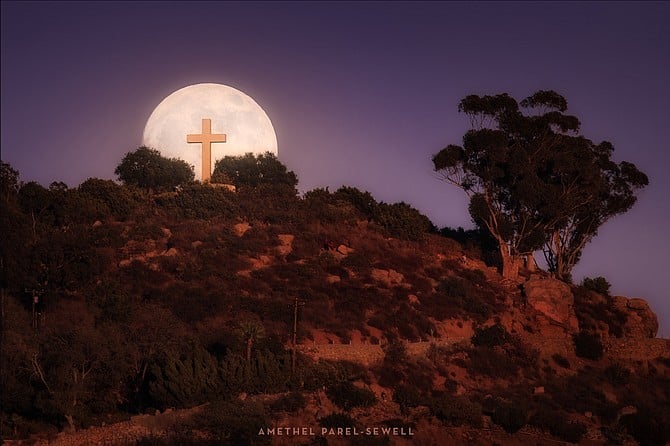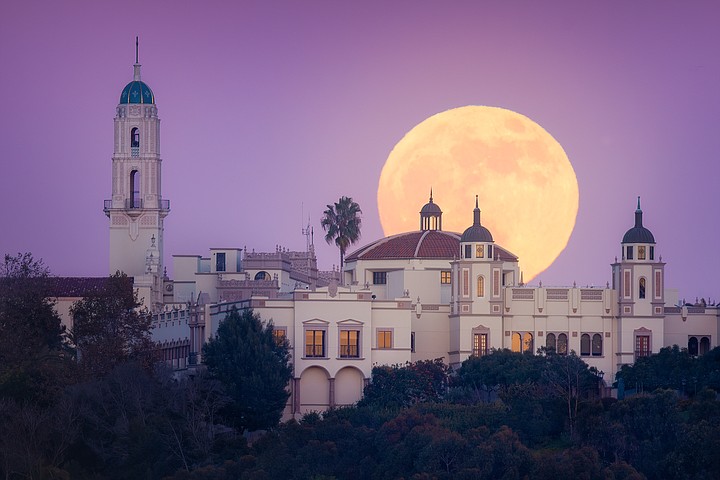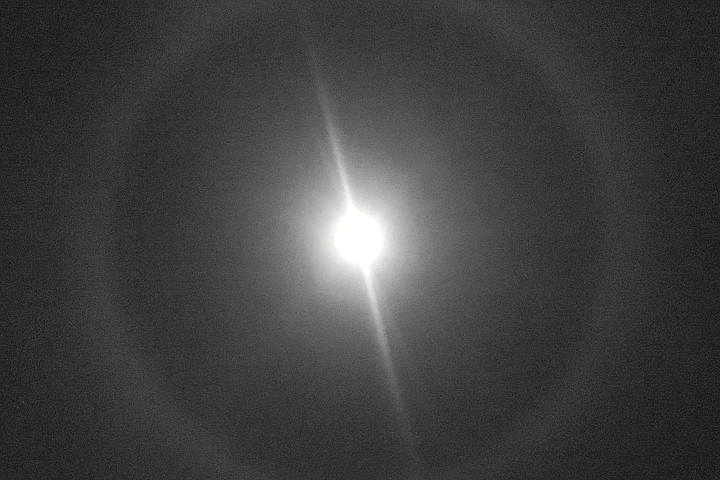 Facebook
Facebook
 X
X
 Instagram
Instagram
 TikTok
TikTok
 Youtube
Youtube

The back of Amethel Parel-Sewell’s business card for Light Chasers (a learning community of photographers) lists 22 elements of a photograph, from Composition and Color to Tones and Texture, with stops at Emotion, Light, and Subject along the way. But she says that for her, “the most important is Moment. One of my personal heroes in photography is Henri Cartier-Bresson. He’s one of the founders of photojournalism, and he coined the idea of the decisive moment. Photography is capturing this fleeting fraction of a second in time so that it lives in eternity. All of the craft work that goes into making a photograph — the technical and creative process — is ultimately about capturing that moment the way you’ve envisioned it.”
On November 28th, I happened upon Parel-Sewell as she was doing just that: capturing the moment the moon rose behind the cross atop Mt. Helix. “That alignment happens only once every three years. I shot it three years ago, but the conditions were more difficult. I had to wait to get another shot at it. I see the cross from my house every day; it’s part of my environment. And every day, I would dream of that shot. Every time I see the moon rising, it kind of takes my breath away. I teach photography and judge at the Fair, but this I do for myself. It’s like therapy. I love it because it gives me this kind of transcendent feeling. To witness this cosmic connection” — the moon touching the earth — “makes me feel alive. It’s like a connection to the divine, if that makes any sense.”

I know whereof she speaks. That same weekend, my 11-year-old called the family outside to see the ring around the moon — a corona that seemed to open a hole in the sky, revealing a blacker blackness beyond the surrounding night. The kids compared it to the shadow of a descending saucer; the wife said it looked like the opening act of judgment day. Everyone stayed standing outside, chilled but transfixed, jaws hanging, necks crimping. We picked up on the transcendence, but my photo…did not capture the moment.
“I like to shoot the moon interacting with the environment,” says Parel-Sewell. “I started as a photojournalist, and to me, authenticity is key. Often, people will just Photoshop a moon into a scene. But when the moon interacts with the buildings and landscape, you can’t fake that. The environment won’t take in the light in a natural way.” Authenticity, of course, is hard to come by; as she says, “this kind of photography is 80 percent planning.” First, there is the matter of equipment. “To achieve the ratio where you get a giant moon over a landscape, you have to have a long focal length, at least 500 millimeters, and you have to shoot from a distance.” (Her shooting location is over a mile away from the cross.) Next is the matter of timing. “The moon rises so fast; if you’re trying to get an exact alignment, you have to be in the exact right place at the exact right time.” Happily, there’s an app for that: PlanIt! for Photographers, which allowed her to pick the landmark she wanted to shoot (the cross), find the moment of moonrise, and then figure out the precise spot from which to shoot (a concrete slab jutting out from the road). “Five seconds later, and it would have been off center.”

But it’s the other 20 percent, after you’ve done your planning and picked your spot, that’s the tricky part. “You’re in a spiritual mode, but your technical ability has to be on in the moment. Every landscape is different. You have to shoot so the moon is in focus, and so that its highlights aren’t blown out in comparison to what is usually a darker scene. You have to consider ambient light.”
As noted, she didn’t always pursue such elevated material. “I’ve wanted to be a photographer since I was 10, and I got my training in photojournalism at Western Kentucky University.” There, “I fell in love with anthropology and folk studies, and so my interest was in documenting peoples and cultures, and landscapes and ways of life. I see myself as a lifelong learner, and photography was a conduit for that. I loved photojournalism, but I got burned out; it was exhausting. Since coming to San Diego in 2013, I’ve been able to get back into photography the way in which I intended.” Why? “I’ve traveled the world. The light here in San Diego is the most magical that I’ve ever experienced. My family came here on a visit from the Midwest, and as soon as I crossed the bridge from the airport to the parking lot, there was this breeze that came through, and the palm trees started dancing in this golden light. I looked at my husband and said, ‘This place is magical.’ Not just the light; the diversity of the landscapes. It’s unmatched.”


The back of Amethel Parel-Sewell’s business card for Light Chasers (a learning community of photographers) lists 22 elements of a photograph, from Composition and Color to Tones and Texture, with stops at Emotion, Light, and Subject along the way. But she says that for her, “the most important is Moment. One of my personal heroes in photography is Henri Cartier-Bresson. He’s one of the founders of photojournalism, and he coined the idea of the decisive moment. Photography is capturing this fleeting fraction of a second in time so that it lives in eternity. All of the craft work that goes into making a photograph — the technical and creative process — is ultimately about capturing that moment the way you’ve envisioned it.”
On November 28th, I happened upon Parel-Sewell as she was doing just that: capturing the moment the moon rose behind the cross atop Mt. Helix. “That alignment happens only once every three years. I shot it three years ago, but the conditions were more difficult. I had to wait to get another shot at it. I see the cross from my house every day; it’s part of my environment. And every day, I would dream of that shot. Every time I see the moon rising, it kind of takes my breath away. I teach photography and judge at the Fair, but this I do for myself. It’s like therapy. I love it because it gives me this kind of transcendent feeling. To witness this cosmic connection” — the moon touching the earth — “makes me feel alive. It’s like a connection to the divine, if that makes any sense.”

I know whereof she speaks. That same weekend, my 11-year-old called the family outside to see the ring around the moon — a corona that seemed to open a hole in the sky, revealing a blacker blackness beyond the surrounding night. The kids compared it to the shadow of a descending saucer; the wife said it looked like the opening act of judgment day. Everyone stayed standing outside, chilled but transfixed, jaws hanging, necks crimping. We picked up on the transcendence, but my photo…did not capture the moment.
“I like to shoot the moon interacting with the environment,” says Parel-Sewell. “I started as a photojournalist, and to me, authenticity is key. Often, people will just Photoshop a moon into a scene. But when the moon interacts with the buildings and landscape, you can’t fake that. The environment won’t take in the light in a natural way.” Authenticity, of course, is hard to come by; as she says, “this kind of photography is 80 percent planning.” First, there is the matter of equipment. “To achieve the ratio where you get a giant moon over a landscape, you have to have a long focal length, at least 500 millimeters, and you have to shoot from a distance.” (Her shooting location is over a mile away from the cross.) Next is the matter of timing. “The moon rises so fast; if you’re trying to get an exact alignment, you have to be in the exact right place at the exact right time.” Happily, there’s an app for that: PlanIt! for Photographers, which allowed her to pick the landmark she wanted to shoot (the cross), find the moment of moonrise, and then figure out the precise spot from which to shoot (a concrete slab jutting out from the road). “Five seconds later, and it would have been off center.”

But it’s the other 20 percent, after you’ve done your planning and picked your spot, that’s the tricky part. “You’re in a spiritual mode, but your technical ability has to be on in the moment. Every landscape is different. You have to shoot so the moon is in focus, and so that its highlights aren’t blown out in comparison to what is usually a darker scene. You have to consider ambient light.”
As noted, she didn’t always pursue such elevated material. “I’ve wanted to be a photographer since I was 10, and I got my training in photojournalism at Western Kentucky University.” There, “I fell in love with anthropology and folk studies, and so my interest was in documenting peoples and cultures, and landscapes and ways of life. I see myself as a lifelong learner, and photography was a conduit for that. I loved photojournalism, but I got burned out; it was exhausting. Since coming to San Diego in 2013, I’ve been able to get back into photography the way in which I intended.” Why? “I’ve traveled the world. The light here in San Diego is the most magical that I’ve ever experienced. My family came here on a visit from the Midwest, and as soon as I crossed the bridge from the airport to the parking lot, there was this breeze that came through, and the palm trees started dancing in this golden light. I looked at my husband and said, ‘This place is magical.’ Not just the light; the diversity of the landscapes. It’s unmatched.”
Comments